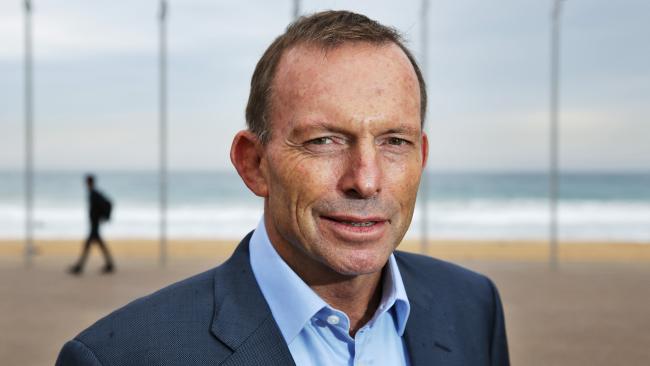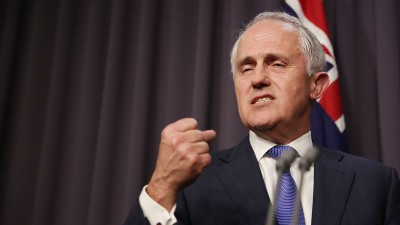Tony Abbott’s RET, emissions policies made energy policy a farce
The Australian
Judith Sloan
12 August 2017
Tony Abbott may have seen the light on energy policy since ceasing to be prime minister. But when he had the top job, he made two fatal mistakes.
The first was to agree to the renewable energy target being renegotiated rather than ditched or paused. The second was to agree to the emissions reduction targets of 26 per cent to 28 per cent on 2005 levels by 2030 as part of our commitment to the Paris climate agreement.
What was he thinking? He may claim he acted on the basis of dodgy advice — and there was an overabundance of it at the time (and still is) — but he was warned on both matters. He decided to go with the flow. Take the decision to lower the RET from the ludicrous target of 41,000 gigawatt hours to be sourced from renewable energy by 2020 (I’m just talking large-scale here) to 33,000GWh. This was complete madness given the costs that additional intermittency imposes on the entire system.
But sneaky modellers with an agenda to push were able to get away with the laughable prediction that wholesale energy prices would fall with this reworked RET, compared with its abolition.
To reach this absurd conclusion, the modellers assumed all the existing fossil-fuel generators would continue to operate until at least 2040. That is, there would be no retirement of reliable baseload electricity in that entire period.
Just think about it: the wholesale price of electricity was going to fall because of the increased supply of subsidised renewables but loss-making coal-fired power stations were just going to keep chugging along. Even a frazzled prime minister should have been able to see through this ruse, let alone an environment minister with more time on his hands.
And here’s a bit of the folklore peddled by the rent-seeking renewables sector: that the cost of renewable energy has fallen so much that it is cheaper than coal. If that is true, the RET should be terminated immediately because the sector no longer needs the implicit subsidy of about $80 a tonne of CO2.
But again, think about it. Why is the cost of renewable energy falling so quickly? Is it because the cost of all that steel and engineering in those vast wind turbines is declining at a rapid rate? To be sure, the new turbines are getting bigger and more efficient but the strength of the objections to their location also is growing. This aspect of wind energy extension has to be taken into account when estimating the cost of renewables.
And while there may be more technology breakthroughs with large-scale solar, and all that cheap Chinese manufacturing helps, there is often an underestimate of the maintenance associated with solar — in particular, the need for the panels to be kept clean.
The best estimates point to annual falls of 1 per cent and 3.5 per cent respectively in the cost of wind and solar. But these figures do not take into account the cost of backup, which we are led to believe will be a required part of all new renewable energy offerings.
This condition will lead to a doubling or trebling of the cost of renewables, given that wind works only when the wind blows (and not too hard), and solar when the sun shines. Be aware that there is a lot of lobbying behind the scenes by the renewable energy sector to water down this requirement.
So, what has happened since the RET was renegotiated in 2015? The wholesale price of electricity has doubled from $60 a megawatt hour to $120. With the closure of the Northern and Hazelwood coal-fired power stations, high-priced gas is increasingly the marginal fuel that is setting the price.
Needless to say, the remaining coal-fired power stations are making thumping profits — the Queensland government-owned plants are swimming in dough as they game the system to return obscene dividends to the state government — as are the renewable energy players.
Is it any surprise that households and businesses are feeling the pressure from higher electricity prices? Note that electricity costs as a proportion of household budgets and business expenses have never been this high in Australia. South Australia has the highest retail electricity prices in the world, with some of the other states not far behind.
Rather than confront the real reasons behind this disaster, both present and impending, all the Turnbull government can do is faff around with marginal issues. Yes, it is a pity that so much gas is being exported. But under the RET, gas plays no part.
And does anyone really think that a ban on gas exports — imposed by a Coalition government, no less — will really put downward pressure on domestic gas prices in any timeframe other the short term?
The message is: don’t bother to explore and exploit because the government is intent on reducing gas prices. (Hey, maybe the government should put export bans on beef, wheat, wool, sugar, iron ore and so on — think of the lower domestic prices we could enjoy!)
Jawboning the states to remove their moratoriums on gas exploration has been completely ineffective, and bullying the electricity retailers will have a marginal effect at best. In fact, the loss of scope for retailers to hedge forward electricity prices, given the greater penetration of renewables, means the quality of retail offerings will deteriorate across time, irrespective of any regulatory action imposed by the government.
This brings me to the nonsensical decision of the Abbott government to promise an excessively high emissions reductions target as part of our Paris Agreement commitment. No doubt the internationalists at the Department of Foreign Affairs and Trade were telling the prime minister we had to do our bit and hold our head high in the UN community.
The trouble for Australia is that 26 per cent to 28 per cent emissions reduction is actually 50 per cent to 52 per cent in per capita terms. With our population growth being more than three times higher than the average in developed countries, we voluntarily have agreed to putting a burdensome yoke around our collective neck.
And here’s another thing: we tend to take these sorts of commitments seriously and accurately measure our emissions. Plenty of countries signed up to the Paris Agreement simply for the money. There is also evidence of widespread rorting of the measurement of emissions, including by Russia and China, both of which are substantial emitters.
To those who argue the solution to our energy problems is the clean energy target, my response is: you have to be joking. The CET is just the RET by another name.
And even if the emissions intensity benchmark is nominally set to include clean coal — note that 1600 clean coal electricity plants are being built around the world — the key parameter is the emissions reduction target.
There will be no private investment in clean coal in this country under a CET unless the emissions reduction target is scaled back. When Malcolm Turnbull points out that coal will feature in electricity generation for years to come, all he is saying is that existing plants will continue to operate and some may even reach their true physical end of life. But there will be no new investment in coal-fired electricity.
Let’s face it: energy policy is a farce in this country. It makes other countries look like paragons of common sense. The US is swimming in cheap shale gas and has reduced its emissions without any intrusive government dictates, aside from some loony and ineffective measures by some of the states.
Germany is building a large brown-coal-fired electricity power plant and has deferred the withdrawal of brown coal to a later date. Denmark has gone cold on wind power, having recently cancelled a large offshore project. Britain is building a new nuclear power plant.
By contrast, Australia seems hellbent on sending all our energy-intensive industry broke as well as imposing ever higher energy bills on households. There has to be a better way.
The Australian

Judith Sloan spoils an otherwise solid and sensible article by pushing the myth that Tony Abbott is solely responsible for the current Large-Scale RET, and much else besides. On other scores, Judith has a point, but not in relation to the LRET.
As PM, Tony Abbott was instrumental in getting Dick Warburton to head the 2014 RET Review, a review that spelt the beginning of the end for subsidised wind power in Australia, and which allowed the Abbott government to attack the 41,000 GWh annual renewable target, which had been upped by the Green/Labor Alliance in 2010.
Throughout 2014, Abbott made no secret of the fact that his preferred option was to scrap the RET and to do away with the most colossal corporate welfare scheme in the history of the Commonwealth (see our post here).
This August 2014 article from the AFR sums up Abbott’s position at the time.
Coalition fails to budge on RET pruning
Australian Financial Review
Phillip Coorey
26 August 2014
Pleas by solar and wind companies to leave the Renewable Energy Target untouched have fallen on deaf ears with the government deciding to proceed with a phasing down of the scheme.
While a final position will not be announced until next month, The Australian Financial Review understands the intent is to cut the scheme harder than a compromise scenario that was being pursued by the Environment Minister, Greg Hunt.
The end result will be closer to the abolition scenario advocated by Prime Minister Tony Abbott which would end the scheme by closing it to new entrants and grandfathering existing large scale projects.
Seeking to overcome the cabinet split, Mr Hunt, Mr Abbott and Industry Minister Ian Macfarlane met on Sunday to discuss a policy position to be put to the bureaucracy for analysis and then to the cabinet for a final decision.
The government is being guided by the findings of the review into the RET conducted by businessman Dick Warburton, a person the industry has argued is ill-suited to the task because he is a climate-change sceptic.
The guiding principles of the final decision will be to balance investor risk with the impact of the RET on household and business power bills. Mr Abbott claims the RET has had a significant impact on power prices. The government’s own modelling shows while the RET has added $40 a year to average household power bill, prices will fall over the medium term as more renewable energy is produced.
The industry is ramping up its warnings that any dilution of the current scheme will not only jeopardise more than $11 billion in the renewable energy investment pipeline, but create a broader sovereign risk perception for Australia.
Close watch on outcome
Philip Green, the London-based partner of the Children’s Investment Master Fund (TCI), which has a 33 per cent stake in renewable energy company Infigen, said the issue was being watched closely. “Sovereign risk has already increased in Australia given the media coverage of the carbon debate and now the RET. Sovereign risk will increase more if the stories about cuts to the RET are confirmed,” he said in a statement.
“This comes at a cost to the nation through higher capital costs as it seeks future investment in infrastructure. The Australian RET had strong bi-partisan political support [including from the current prime minister]. It can take a long time to restore trust and in some cases this is only achieved with a change in leadership/policy/party.”
Under the RET, a policy which hitherto had bipartisan support, 20 per cent of Australian’s energy production by 2020 would come from renewable sources. Based on earlier predictions of power production in 2020, this 20 per cent target was calculated at an annual production of 41,000 gigawatt hours.
But the 2020 production total has been downgraded following the decline of the manufacturing sector, including automotive and aluminium.
Consequently, 20 per cent of the revised production target is 27,000 GWh. This is the “real 20 per cent” scenario for which Mr Hunt is advocating.
Under the push by Mr Abbott, renewable energy output would be frozen at current levels of about 16,000 GWh.
Any proposed change faces a near impossible passage through the Parliament with Labor and the Greens opposed to any alteration, while Clive Palmer says he will not allow any change unless Mr Abbott goes to the next election in 2016 and wins a mandate.
Australian Financial Review
For Judith Sloan’s benefit and the benefit of others wedded to the myth that Tony Abbott is responsible for the current 33,000 GWh target, we’ll set it out again:
Under the push by Mr Abbott, renewable energy output would be frozen at current levels of about 16,000 GWh.
Had Abbott’s 16,000 GWh target eventuated, it would have been satisfied by the renewable generation capacity that then existed; and there would have been no further addition of either wind or solar power generating capacity, at all.
As Judith is well aware, the Liberal/National Coalition did not control the Senate during Abbott’s term as PM, resulting in the ultimate compromise.
At the time, Abbott’s Environment Minister, Greg Hunt was in bed with the wind industry and being pushed to keep the target as high as possible, hence the reference above to Hunt’s push for a 27,000 GWh target.
Labor recognised that if the 41,000 GWh target had remained in place, there would have been an annual shortfall of renewable energy generated (in the order of 25,000 GWh).
That shortfall would result in the imposition of the shortfall penalty charge, adding $2.35 billion annually to power bills – a ‘stealth tax’ that would operate at that rate until 2031 (see our post here): political suicide for both the Coalition and Labor, hence their willingness to negotiate a reduced target.
Despite Abbott’s efforts, and over his private objections, Hunt’s office (which included a number of wind industry plants, such as Patrick Gibbons) negotiated the reduction of the ultimate annual LRET target from 41,000 to 33,000 GWh – more than double what then PM, Tony Abbott was pushing for.
Tony Abbott did not get what he was after, but that’s the nature of politics and government. Had he done so, STT wouldn’t be writing this post, and there would have been a whole lot less to write about over the last three years.
Instead, Australia is presently stuck with a Renewable Energy Target that can never be met, a policy that has all but destroyed Australia’s once affordable and reliable power supplies.
What happens next is up to the man who stabbed Tony Abbott in the back in September 2015, Malcolm Turnbull. Or, rather, the dozens of Liberal and National MPs who now recognise the LRET as a clear and present danger to their very own political futures. What happened on Tony Abbott’s watch is history, it’s what happens now that matters.



Judith Sloan is quoted as writing “note that 1600 clean coal electricity plants are being built around the world”. Maybe she doesn’t know the difference between clean coal (nice term, that one) and traditional, dirty coal generation.
I find that 1600 difficult to believe. Even the untrustworthy WattsUpWithThat blog only claims 1600 coal plants planned or under construction globally – not clean coal, only coal. (Ref. 1)
Does anybody know where the number comes from? Maybe NYT, in an article which was cited above by WUWT (Ref. 2)
Perhaps it is a typo – I am aware of only a handful of clean coal proposals globally two of which in USA were recently shelved.
Besides which, in order to qualify, as AFR states: “they would have to gut the guidelines to get the [clean] coal plants over the line.” (Ref. 3).
(Ref. 1) https://wattsupwiththat.com/2017/07/03/forget-paris-1600-new-coal-power-plants-built-around-the-world/
(Ref. 2) https://www.nytimes.com/2017/07/01/climate/china-energy-companies-coal-plants-climate-change.html?smid=tw-share
(Ref. 3) http://www.afr.com/news/clean-coal-billions-of-dollars-and-lots-of-carbon-20170213-guc03f.
Not sure where Judith gets 1600 from, but The Australian article in the post below gives a figure of 1,200 HELE plant across Asia, with 45 in Japan alone:
The article cites the Minerals Council, so we expect the number to be right.
This website – End Coal – has a ‘tracker’ function that records every coal-fired plant operating, planned or constructed.
http://endcoal.org/global-coal-plant-tracker/
We haven’t had a chance to review it, but it may assist in answering your questions.